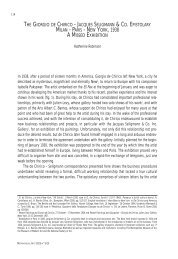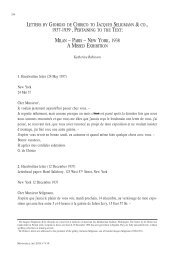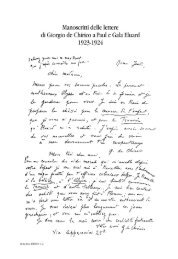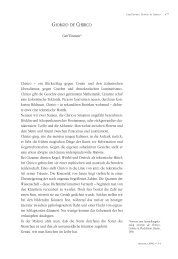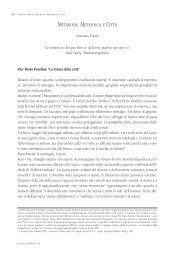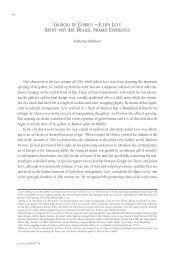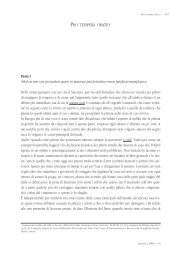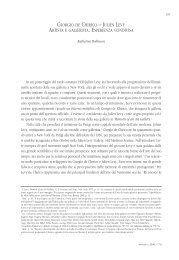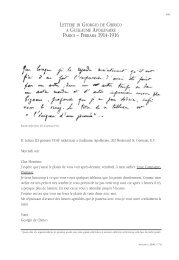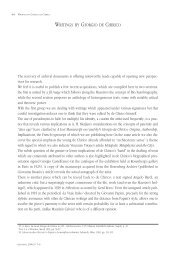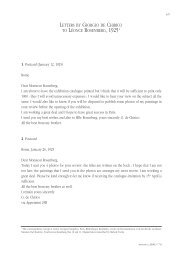Emplastic Oil - Fondazione Giorgio e Isa de Chirico
Emplastic Oil - Fondazione Giorgio e Isa de Chirico
Emplastic Oil - Fondazione Giorgio e Isa de Chirico
Create successful ePaper yourself
Turn your PDF publications into a flip-book with our unique Google optimized e-Paper software.
170<br />
SALVATORE VACANTI: FROM MURAL PAINTING TO “EMPLASTIC OIL”<br />
and elasticity. He first ma<strong>de</strong> the results of his investigation known to the Aca<strong>de</strong>my of Science in<br />
1931 and then again in 1933. He was thus able to commercialise his renowned medium, which supposedly<br />
shared the same characteristics as the one invented in the fifteenth century by the Van Eyck<br />
brothers. Thereafter he also published a noteworthy manual on painting technique, in which he<br />
<strong>de</strong>scribed the techniques of the Old Masters. 52 Maroger’s research was also known by Gino Severini,<br />
another great master of the Italian Return to Or<strong>de</strong>r. Like <strong>de</strong> <strong>Chirico</strong>, Severini was interested in perfecting<br />
his technique with the substance <strong>de</strong>veloped by the French restorer:<br />
But then, recently in Paris, my friend Raoul Dufy told me he used a medium that, when mixed with<br />
oil paint, presents all the characteristics of Van Eyck’s celebrated paint. And he introduced me to the<br />
inventor: the painter Maroger. 53<br />
According to Severini’s book, Maroger’s medium was an emulsion composed of an aqueous<br />
solution of animal or vegetable glue together with linseed oil – cooked at 200° C with a manganesebased<br />
siccative – mixed while hot with Mastic resin (an oil varnish).<br />
During this new sojourn in Paris, <strong>de</strong> <strong>Chirico</strong> un<strong>de</strong>rwent yet another iconographical transformation:<br />
in 1934 the first group of Bagni Misteriosi (Mysterious Baths) works was presented in ten lithographs<br />
in the dossier Mythologie with texts by Jean Cocteau. The theme was thereafter <strong>de</strong>picted in<br />
a series of seven paintings, including those sent in 1934 to the Roman II Quadriennale. An entire<br />
room was <strong>de</strong>dicated to <strong>de</strong> <strong>Chirico</strong> here, who explained his new works in the catalogue:<br />
The forty-five paintings here exhibited are part of my artistic production of the last two years (1933-<br />
34). I am still pursuing research in invention and in imagination. The paintings Mysterious Baths are<br />
part of these investigations […]. Today more than ever I am interested in the question of “craft” and<br />
of painterly quality. My efforts as a painter are <strong>de</strong>dicated above all to this problem. 54<br />
This interest also comes to light in the artist’s correspon<strong>de</strong>nce with his friend the painter Nino<br />
Bertoletti. 55 A few weeks before the inauguration of the Roman Quadriennale, <strong>de</strong> <strong>Chirico</strong>, unable to<br />
leave Paris, wrote to Bertoletti asking him to take care of the mounting and maintenance of his<br />
paintings:<br />
[…] if it happens that paint has chipped off somewhere on one of these three paintings, please repair<br />
the damage with a veiling; some light brushstrokes with a soft paintbrush and with paint diluted in<br />
52<br />
J. Maroger, The secret formulas and techniques of the masters (1948), Hacker Art Books, New York 1979.<br />
53<br />
G. Severini, Ragionamenti sulle arti figurative, Hoepli, Milan, 1936, pp. 4-7.<br />
54<br />
G <strong>de</strong> <strong>Chirico</strong>, Mostra personale di <strong>Giorgio</strong> <strong>de</strong> <strong>Chirico</strong>, in Seconda Quadriennale d’Arte Nazionale, exhibition catalogue, Tumminelli, Rome 1935, p.<br />
91; now in <strong>de</strong> <strong>Chirico</strong>, Scritti/1…, cit., p. 840.<br />
55<br />
The painter Nino Bertoletti (Rome, 1889-1971) <strong>de</strong>buted on the wake of a generic Divisionism, and thereafter became close to the Roman Secession.<br />
In 1919 he participated in the Return to Or<strong>de</strong>r movement and frequented the artists and literati who met at Caffè Aragno in Rome. In 1929 in Paris he<br />
became close friends with <strong>de</strong> <strong>Chirico</strong>, with whom he exchanged letters until at least the mid 1930s. See Bertoletti, opere 1919-1939, V. Rivosecchi ed.,<br />
De Luca, Rome 1990.<br />
METAPHYSICAL ART 2010|N° 9/10



